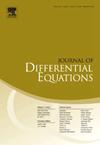三维空间中的无质量狄拉克方程:分散估计和零能量障碍
IF 2.4
2区 数学
Q1 MATHEMATICS
引用次数: 0
摘要
我们研究了带势能的无质量三维狄拉克方程的色散估计。特别是,我们证明了无论是否存在零能量特征函数,狄拉克演化作为从 L1 到 L∞ 的算子都满足〈t〉-1 的衰减率。我们还证明,在任何 0≤γ<1/2 的情况下,这一衰减率都可以改进为〈t〉-1-γ,但需要付出空间权重的代价。这一估计值与 L2 守恒定律一起,使我们可以在阈值特征值的情况下推导出一系列斯特里哈茨估计值。我们将阈值障碍的结构归类为由零能量特征函数组成。最后,我们证明了狄拉克演化在所有时间都是有界的,对势能衰减和初始数据的平滑性要求极低。本文章由计算机程序翻译,如有差异,请以英文原文为准。
The massless Dirac equation in three dimensions: Dispersive estimates and zero energy obstructions
We investigate dispersive estimates for the massless three dimensional Dirac equation with a potential. In particular, we show that the Dirac evolution satisfies a decay rate as an operator from to regardless of the existence of zero energy eigenfunctions. We also show this decay rate may be improved to for any at the cost of spatial weights. This estimate, along with the conservation law allows one to deduce a family of Strichartz estimates in the case of a threshold eigenvalue. We classify the structure of threshold obstructions as being composed of zero energy eigenfunctions. Finally, we show the Dirac evolution is bounded for all time with minimal requirements on the decay of the potential and smoothness of initial data.
求助全文
通过发布文献求助,成功后即可免费获取论文全文。
去求助
来源期刊
CiteScore
4.40
自引率
8.30%
发文量
543
审稿时长
9 months
期刊介绍:
The Journal of Differential Equations is concerned with the theory and the application of differential equations. The articles published are addressed not only to mathematicians but also to those engineers, physicists, and other scientists for whom differential equations are valuable research tools.
Research Areas Include:
• Mathematical control theory
• Ordinary differential equations
• Partial differential equations
• Stochastic differential equations
• Topological dynamics
• Related topics

 求助内容:
求助内容: 应助结果提醒方式:
应助结果提醒方式:


